
Back in 2003, Alistair McGown, today a designer/writer for Panini’s Doctor Who specials and bookazines, and part of design team at Fanderson, conducted three interviews with stalwarts of the much-loved, much-missed weekly comic, Look-in, “The Junior TV Times“. With his kind permission, we’re delighted to represent them here, rescued from the WayBack Machine over at the immensely appreciated Internet Archive… this one with the late Angus Peter Allan, writer extraordinaire…
Angus Peter Allan (22nd July 1936 – 16th July 2007) was a British comic strip writer and magazine editor who worked on TV Century 21 in the 1960s and Look-in magazine during the 1970s. Most commonly known as Angus Allan and sometimes credited as Angus P. Allan, his output was prolific. Virtually all the Look-In comic strips were his creations, ranging from “Danger Mouse” to “The Six Million Dollar Man“.
Allan also collaborated with many well-known British comic artists, including Arthur Ranson, creating two creator-owned strips for Look-In telling the stories of The Beatles and Elvis Presley. The Beatles Story has been republished in a number of languages, digitally by ROK Comics in 2008, and in print by Rebellion, who own the Look-in brand, in 2018.
Alistair McGown’s Introduction to The Interview
Angus P. Allan wrote virtually every other comic strip in classic TV/pop mag Look-In, from its first issue in 1971 until the mid 1980s. A stalwart of the classic Gerry Anderson comic TV Century 21 in the 1960s, his role in Look-In has gone generally uncredited since then, so it was a delight when Angus contacted me from his farmhouse in the South of France.
Angus spends his retirement toiling in his fields, but he graciously gave of his time to remember his days shuttling to and from 247 Tottenham Court Road. I was amazed just how clearly Angus recalled events of the 1970s, but he advised me to be wary of inevitable memory loss. He feels there really should be a warning printed on every bottle of whisky …
Entering the Comics Industry
In a letter to the original Look Out web site, the last snapshot also archived on Wayback in 2009, a published email from Angus outlines how he got into publishing in the 1950s and his later work.
“Basically, Alan Fennell [later editor of TV Century 21 and Countdown] and I started out together as office boys in Amalgamated Press in 1952,” he related. “I was scared stiff of him, because he was a Teddy Boy, complete with light blue suit shot with gold lurex threads, big brothel-creeper shoes, and a haircut containing 99% grease. I imagined he carried a bicycle chain in his pocket with which to beat-up blazer-and-flannels wearers like me.
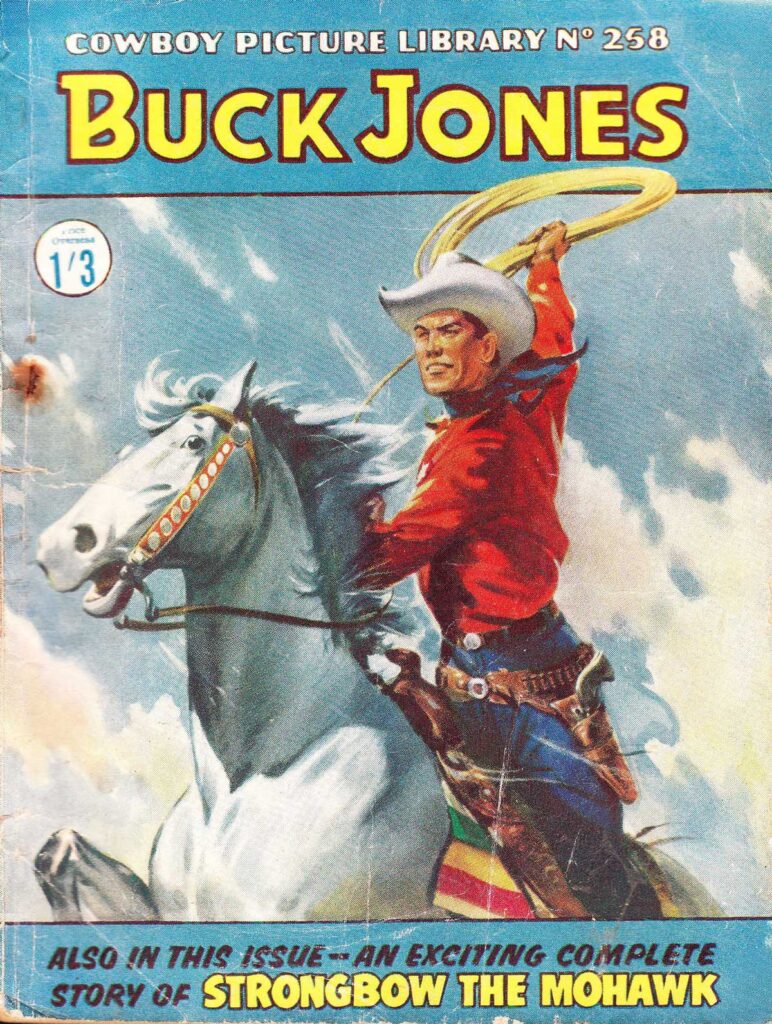
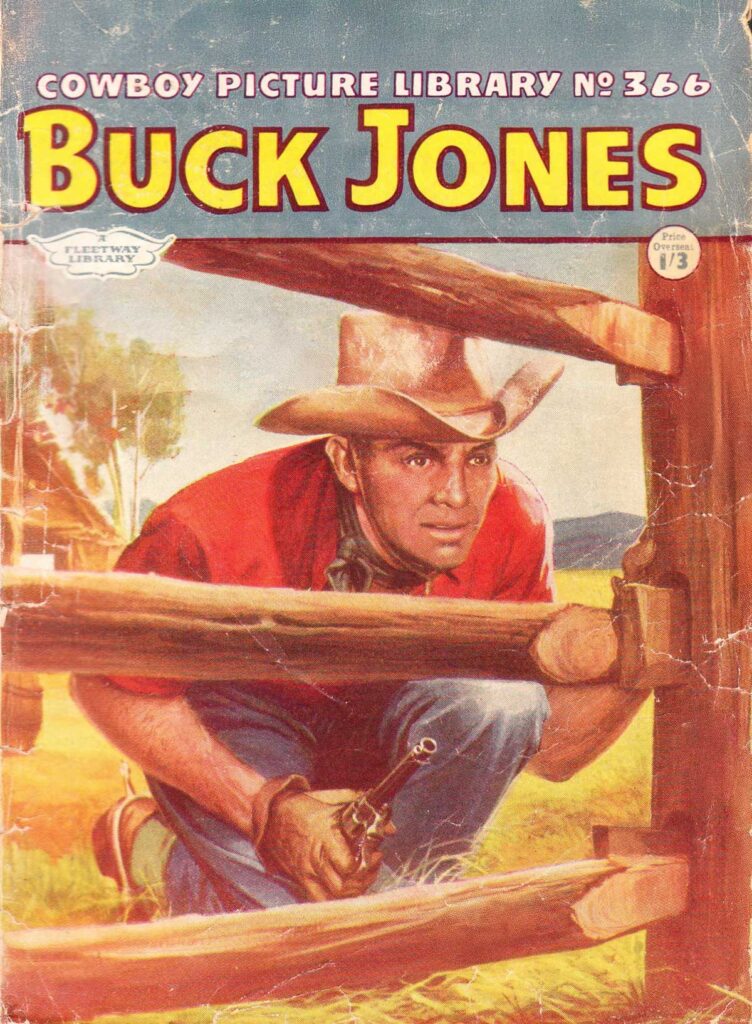
“Not so. We became mates, and after I’d gone off to do National Service, he shed the Teddy Boy image. By the time I came out of the army in November 1956, he was about to join me in harness. We were co-editors of Cowboy Picture Library, under Alf Wallace. The magazine was one of those run by the formidable Len Matthews [Leonard Matthews]. Alan and I wrote many scripts for the publication. We became firm friends, and I was godfather to his twin girls. It’s thanks to one of them that I can write this – because she insisted I have his computer, which he’d just bought, and it was one hell of an upgrade from my old 486, I can tell you! I lost no time in getting on the net.
“Anyway, Alan went his own way – to TV Comic, then as a freelance writer of Stingray scripts for the TV series created by Gerry Anderson. Then Thunderbirds. Then, as editor, of the newly created and wonderfully successful comic, TV Century 21. I wrote plenty scripts for him, and when he launched Lady Penelope, he asked my wife, Gillian Allan, a very accomplished magazine journalist, to edit it. Naturally, I wrote for that publication, too.
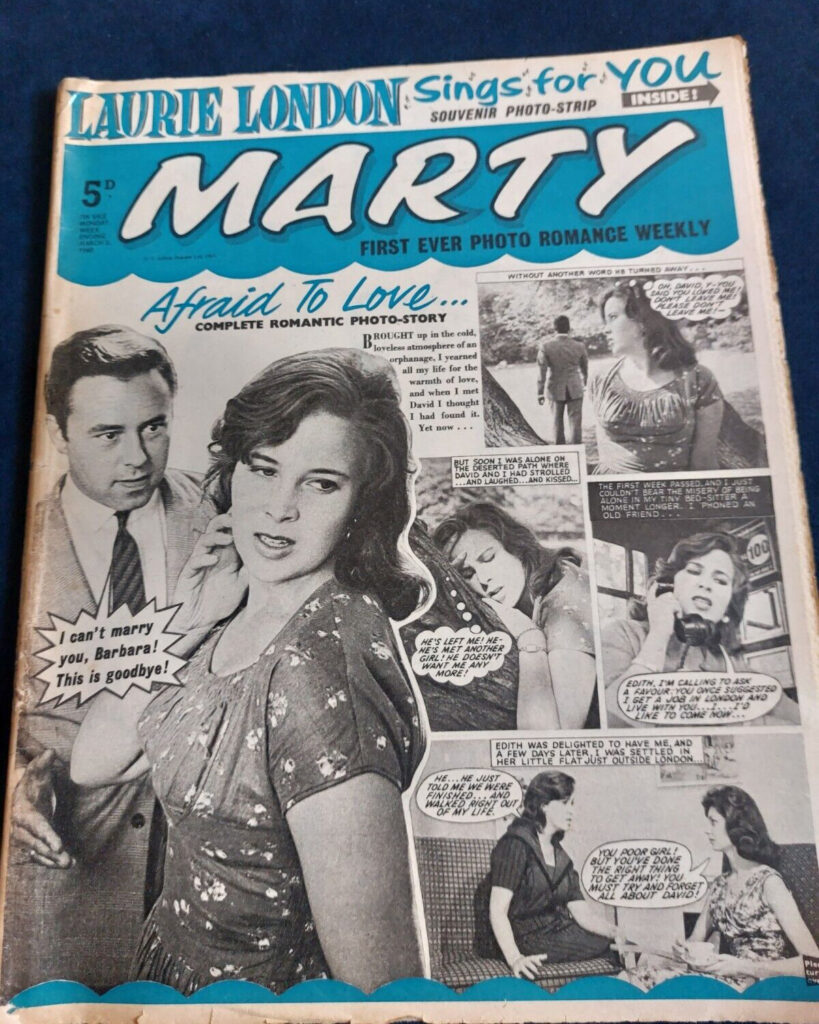
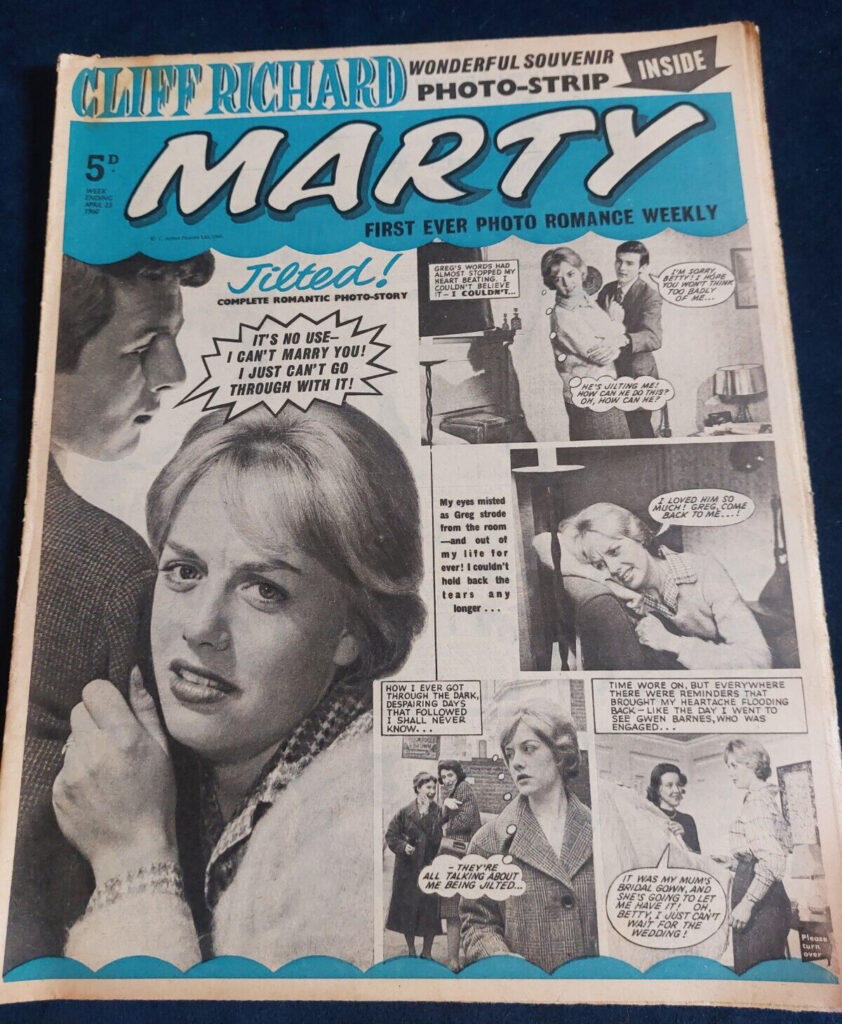
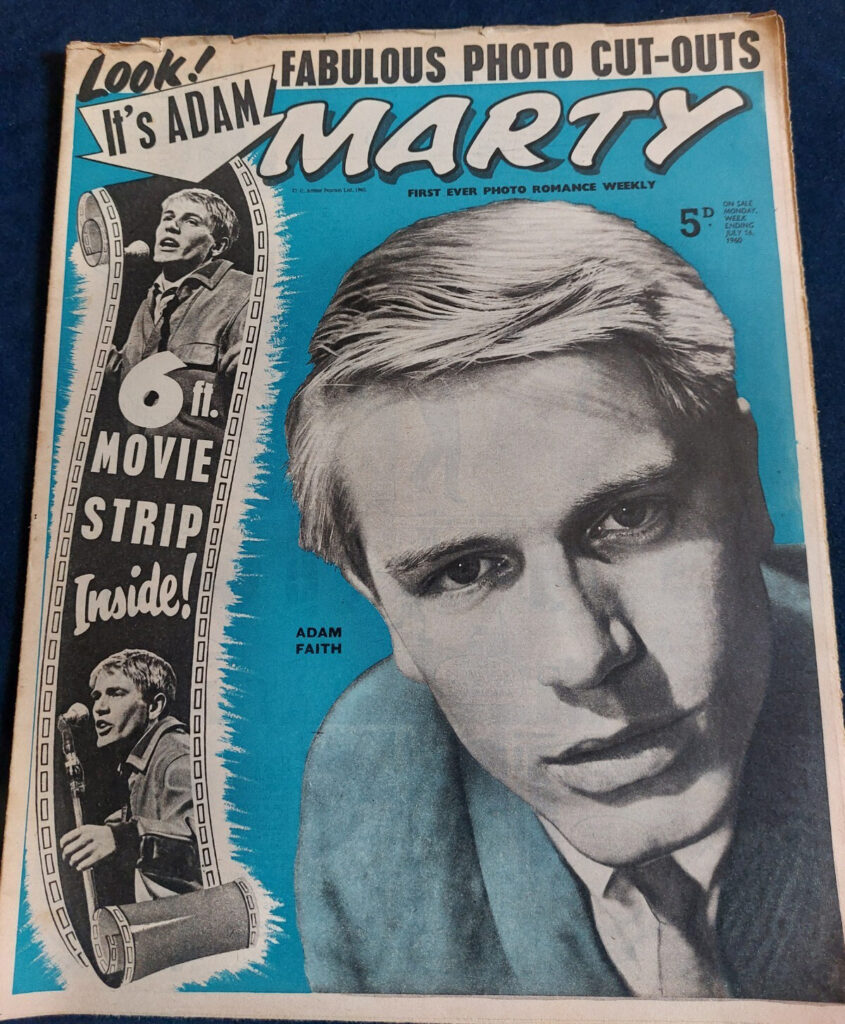
“Gillian and I had met when working for Marty, “The first all-photo romance weekly”, published by Newnes and Pearson. I had been headhunted from Amalgamated Press, and she had come down from a local paper in Lancashire. “She ended up as Chief Sub-editor for Woman’s Own, when it was a real magazine, and not the tripe it is today.
“From TV 21, which was eventually sold to Fleetway, Alan went on to found and edit Look-In. Of course, he asked me to write for it, and the first thing he gave me was a commission to adapt Sir Walter Scott’s “Redgauntlet”. It was a hellish undertaking. Transferring a convoluted Victorian book-plot into a smooth-running picture-strip was well night impossible.
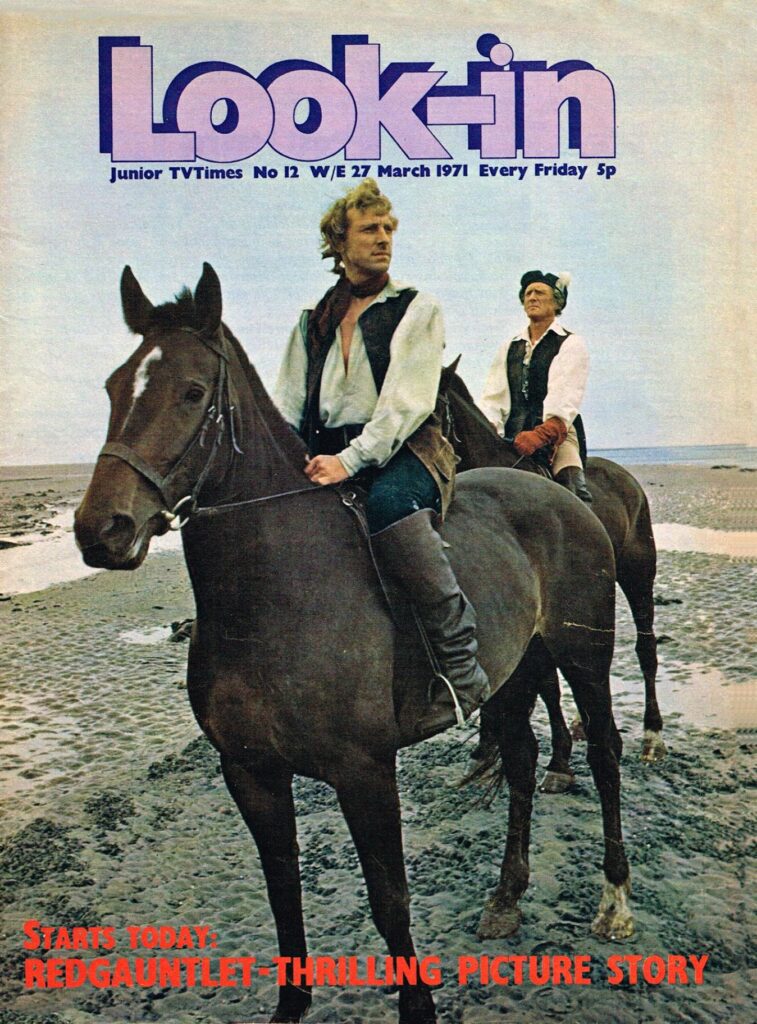
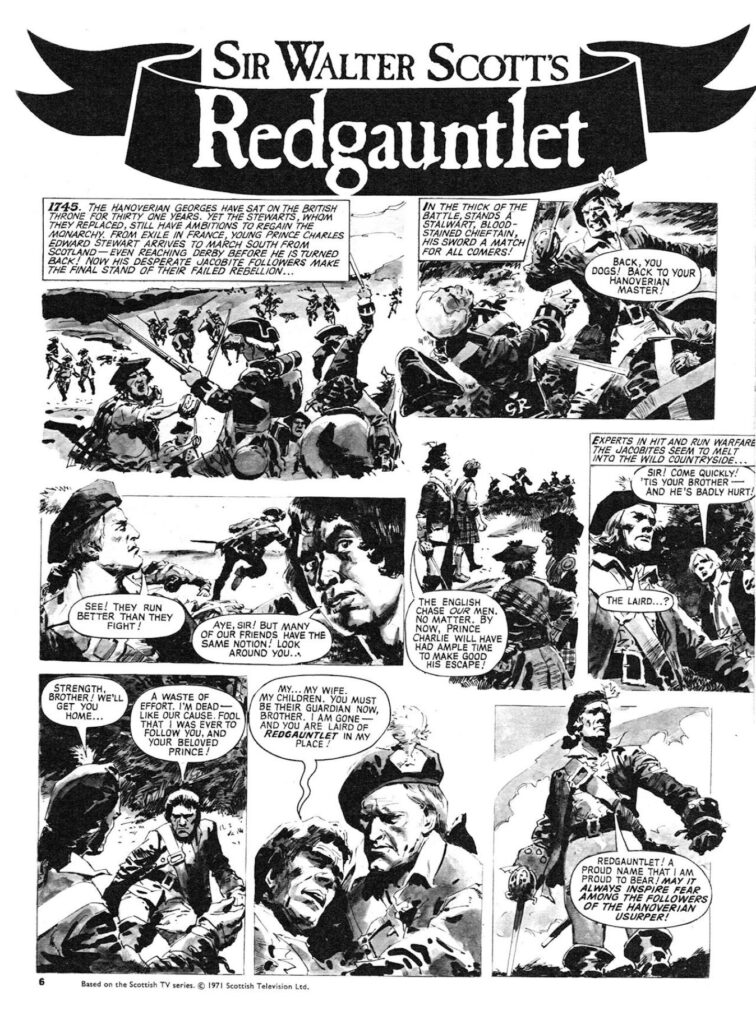
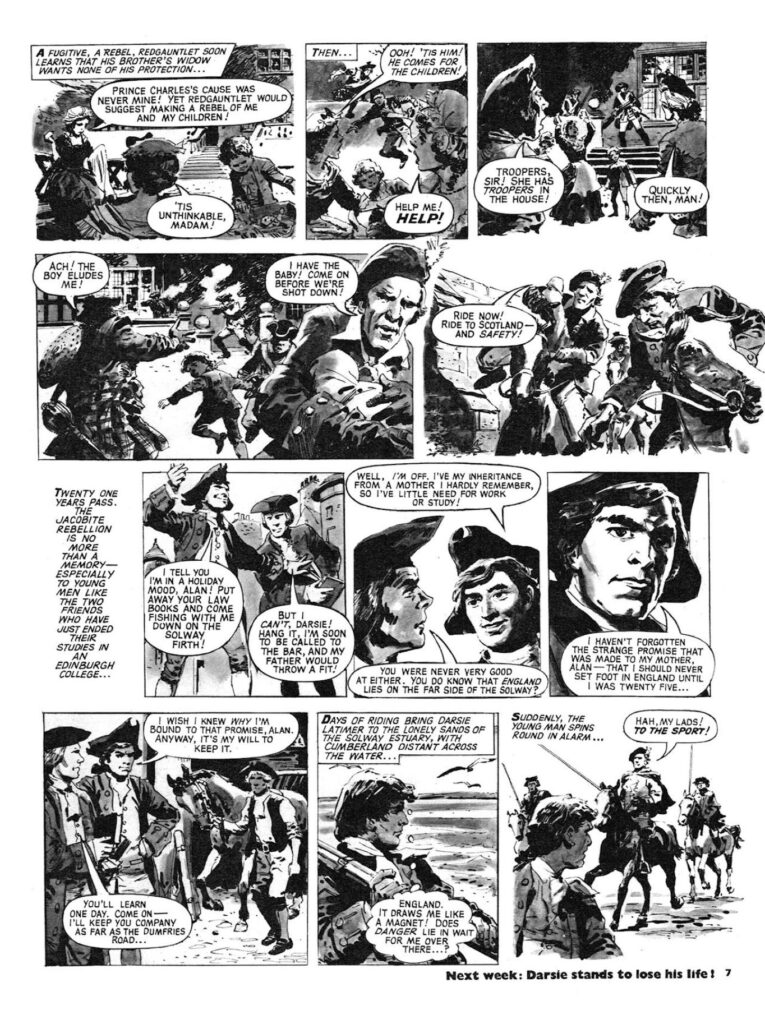
“After that, it was ‘Timeslip’, and gradually I came to write more and more. The list is enormous. ‘The Flaxton Boys’, ‘Catweazle’, ‘Space: 1999’, ‘Buck Rogers’, ‘The Six Million Dollar Man’, “Please Sir!’, ‘Kung Fu’, ‘Robin of Sherwood’ – hundreds and hundreds of them. ‘The Doctor in…’ series, ‘Danger Mouse’ (my personal favourite) ‘The A-Team’, ‘Knight Rider’, ‘Chips’…
“I was especially pleased with the reactions for ‘Danger Mouse’. The artist, Arthur Ranson and I were summoned to Cosgrove Hall in Manchester to receive “Good Grief Oh Crikey” awards.
“Once the decision had been taken to buy a TV series for production as a comic strip, a preview showing of the pilot instalment would be arranged. The editor, myself and the prospective artist would be there. Then I’d go away and produce instalment one and a synopsis of run-on.
“Usually, I had to do it by the next day – and these were original stories, remember, not adaptations of the TV stuff. No sweat: that was my job. The result would be okayed, either in the UK or in the States, depending on the property, and the artist would then go ahead. Usually, I’d written five episodes before the show even got to the public via their TV screens.”
“Look-In eventually went to the wall. I liked the second editor, Colin Shelbourne, very much indeed. But he was totally anti-violence. Of any kind. Well, he was the boss. But to my view, kids like knock-about action, plenty of explosions, and lots of shooting… [Look-in] became a vehicle for stuff like ‘Scooby-doo’ and ‘Inspector Gadget’, and slowly went down the pan. I concentrated on writing ‘Garth’ for the Daily Mirror, and doing this and that annual – ‘Allo ‘Allo, for example.
“Then I decided to cut loose and quit south west London for this beautiful, unspoiled and non-tourist area in the foothills of the Pyrenees… I couldn’t live on [my pension] in the UK, but I can here – wine included!”
The McGown Interview
Alistair: You spent many years at TV Century 21 (and its girls’ stablemate, Lady Penelope) and the story of this classic comic is well documented by Anderson devotees – but in brief, what were your duties there? You were the strips script editor at one point, weren’t you? Did you stay long at this “desk job”?
I started with TV Century 21 as a freelance, pure and simple, at first supplying text features for such things as Stingray Annual – the story of the deepest bathyscaphe dives in the Marianas Trench, for example. I was eventually approached by Alan Fennell, who, with the advent of Lady Penelope magazine, reckoned that he really needed a Script Editor to look after all the mechanics of strip production – making sure stories were scripted in time, properly sub-edited so that they made sense, sent to the right artists, properly drawn to specification, correctly and readably lettered by lettering artists – and so forth.
It made my job easier if I wrote a percentage of the strips myself. No problem there. However, I remained behind a desk at the TV Century 21 office for only a year or so. Perhaps 18 months. I hated office routine, and eventually Alan and I both felt we’d all be happier if I went freelance again as a scriptwriter. Certainly, office tensions (artists being late with their work and so forth) were not to my taste. I almost came to blows with one artist’s agent on one occasion, such was my frustration.
Also, Alan’s immediate henchmen, Tod Sullivan and Dennis Hooper [later editor of Countdown comic – Alistair], incorrectly assuming that I was after their jobs, were keeping diaries on my comings and goings to and from various Fleet Street pubs, and showing them to Alan.
Alan called me in at one time, tossed me the diaries and said: “What do you think of these?” I replied: “Christ. Haven’t those twerps got any work to do?” He nodded, grinned, and that was that.
What about “The Daleks” comic strip at TV Century 21? This was credited on the page to Terry Nation, but it’s usually accredited to David Whitaker [John Ainsworth’s articles in Marvel UK’s Doctor Who Classic Comics states this, with Alan Fennell joint writing Episode One. David Whitaker’s nephew [artist] Steve has also contacted me to say that most if not all were Whitaker’s, including, most definitely “The Archives of Phryne”, whch he recalls discussing with his Uncle prior to publication. Steve also suggests writer/artist Eric Eden may have scripted on occasion. Reading episodes of it again, surely Angus Allan took a hand in this somewhere?
I took no hand whatsoever with “The Daleks” strip, except that on one occasion the writer (I always assumed that Nation wrote the strip himself, but it may have been Whitaker) either fell ill or was otherwise indisposed, and I had to do a couple of weeks of fill-in – that is, advancing the story without actually altering storyline or plot. A tricky enough task!
What I do remember is that I very unexpectedly received a cheque – from Terry Nation, and I am certain of that much – with a letter of thanks. (I was actually in-house as Script Editor at the time). He insisted that he had no right to money for which he had done no work. It was a most generous gesture, and what’s more, he paid me at his rate, which, naturally, was many times my own.
TV Century 21 had a lean period towards the end of its life, going through all sorts of format revisions and cutbacks. What was it like to work on at that time and did you stay the course? Century 21 Publishing wound up in Summer 1969 but TV21 continued with Marts Press and City Magazines. The Anderson content finally disappeared with the demise of “Thunderbirds” in June 1970, but the comic continued with “Star Trek” and reprints, until merging with Valiant in September 1971.
I’d assume you’d severed all ties with TV21 by January 1971 at the latest, to start at Look-In?
I remained with TV21 almost until the end. I went with it, as freelance, you understand, to Martspress – which, coincidentally, had been founded by an ex-boss of Alan Fennell’s and mine – Leonard J. Matthews. I had no problems. I have always regarded scriptwriting as a job of work that I am lucky enough to be able to do. It was another coincidence when TV21 merged with Valiant. I had been freelancing for Valiant for years!
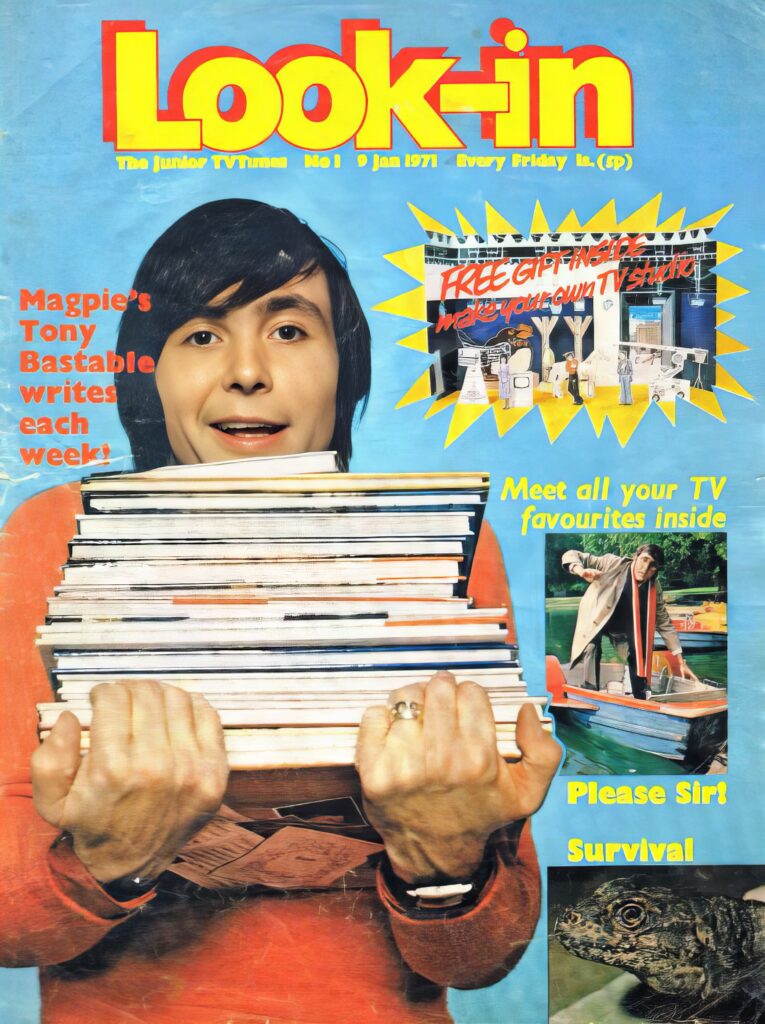
Moving to Look-In – how did the comic come about as a ‘junior TV Times‘? It’s said that it was originally supposed to somehow tie-in with Thames’ magazine series Magpie and indeed Magpie was its working title.
Look-In was, as you correctly surmise, originally intended to be connected with Magpie. Alan Fennell had done the dummy – he was most adept at dreaming up magazines and creating dummies. He had, as you can imagine, many contacts in the magazine publishing world, and TV Times took an immediate interest in the projected publication.
With Alan Fennell as editor and Colin Shelbourn as art editor, where did Angus Allan fit into all of this and were you involved in its early conception as a comic, or were you always going to be ‘the strips man’? Did you come on Alan’s recommendation? Did you have a desk in the office or stay freelance?
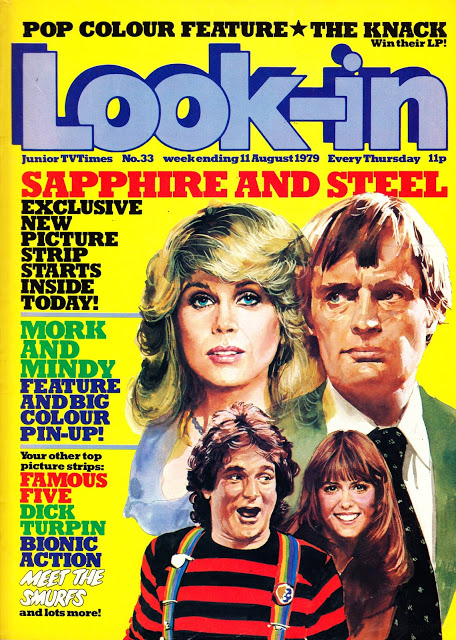
Being very close to Alan Fennell, I was naturally involved from the start. However, he never forgot that I preferred the precincts of a pub to those of an office, and I remained freelance. I worked entirely from home, coming up to the office in Tottenham Court Road maybe three times a week. Usually at lunchtime, so that Alan and I could go and stuff our faces at the magazine’s expense. We were both enthusiastic gourmets.
Alan and I always remained very close friends until his death a couple of years ago.
I’d said on my Sapphire & Steel site that you wrote nearly every strip for Look-In, but you tell me that this is truer than I originally thought. I wondered if you had written any of the comedy strips – “Man About the House”, “Mork and Mindy”, or pop strips “Slik Stories”, “It’s Flintlock”) and indeed you did!
You didn’t write the “Benny Hill” page or the [comedian] Leslie Crowther-inspired “Crowther in Trouble”… I wonder if I can catch you out on any more … How about “On the Buses”? Les Dawson’s “Superflop?” How about those nutty David Cassidy strips. where he would save a plane from hijacking!? “The Kids from 47A”? “Starcruiser”? “Mind Your Language” – would you admit to that one?! “Bucks Fizz”?
I have no record of exactly which strips I wrote for Look-In in later years, but I had made a rough and possibly not complete listing for a party celebrating some anniversary or another of Look-In’s publication [it looks like the tenth birthday in 1981 to me – Alistair]. I would have set it to music, and played it, only they wouldn’t let me!
“Timeslip”, “Wreckers At Dead Eye”, “Redgauntlet”, “Prize Idiots”, “Follyfoot”, “The Flaxton Boys”, “Please, Sir!”, “The Fenn Street Gang”, “Catweazle”, “Doctor At Large”/ “At Sea”/ “On The Go”, “Adventures of David Cassidy”, “Elephant Boy”, “Settle Down With Ken Goodwin”, “The Tomorrow People”, “Bless This House”, “Kids From 47a”, “Kung Fu”, “Adventures of Black Beauty”, “The Six Million Dollar Man”, “Space: 1999”, “Man About The House”, “Slik”, “The Bionic Woman”, “Flintlock”, “Just William”, “Abba”, “The Man From Atlantis”, “Logan’s Run”, “The Famous Five”, “How The West Was Won”, “Mind Your Language”, “Dick Turpin”, “Worzel Gummidge”, “Chips”,” Sapphire And Steel”, “Battlestar Galactica”, “Charlie’s Angels”, “Mork And Mindy”, “The Further Adventures of Oliver Twist”, “Buck Rogers”, The Beatles Story”, “Danger Mouse”, “The Fall Guy” …
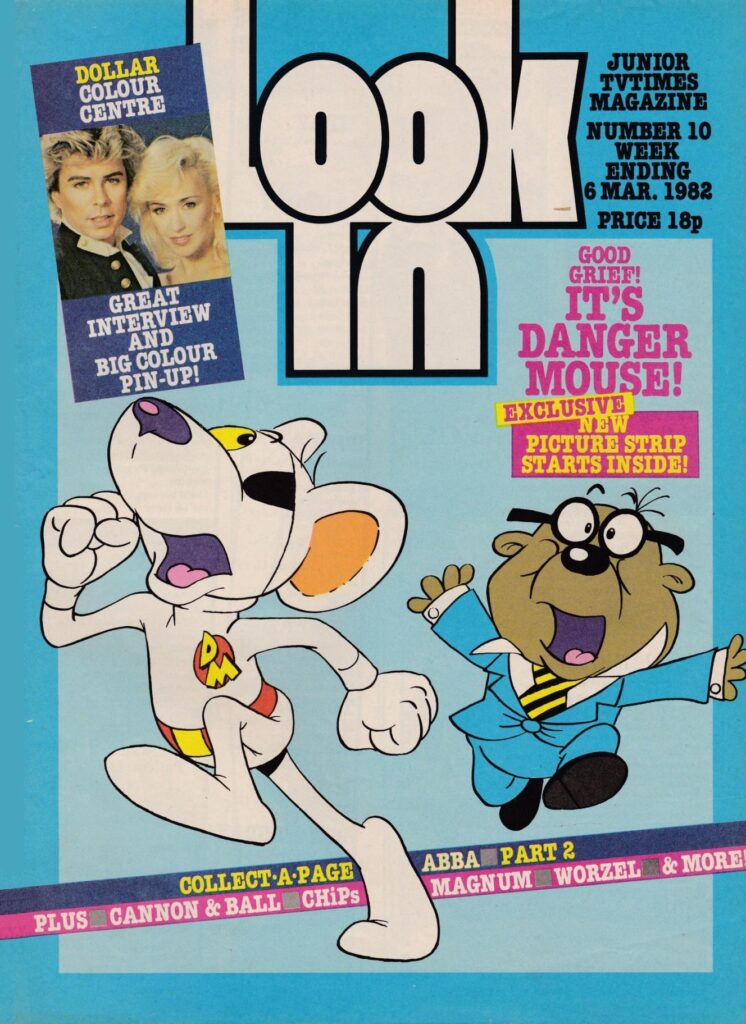
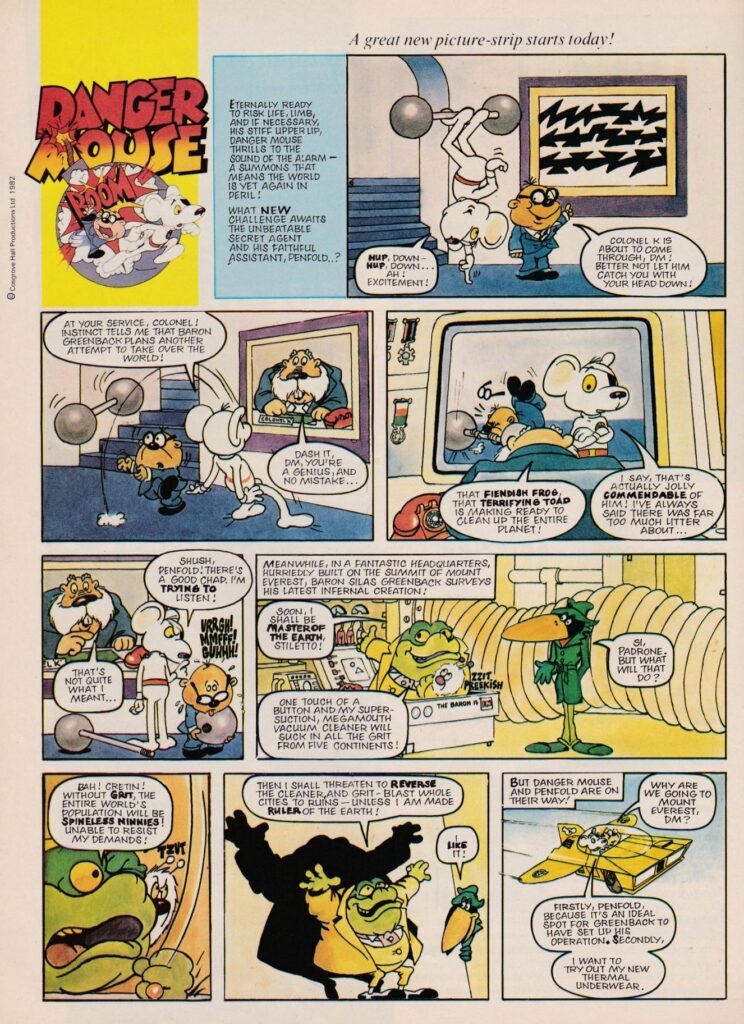
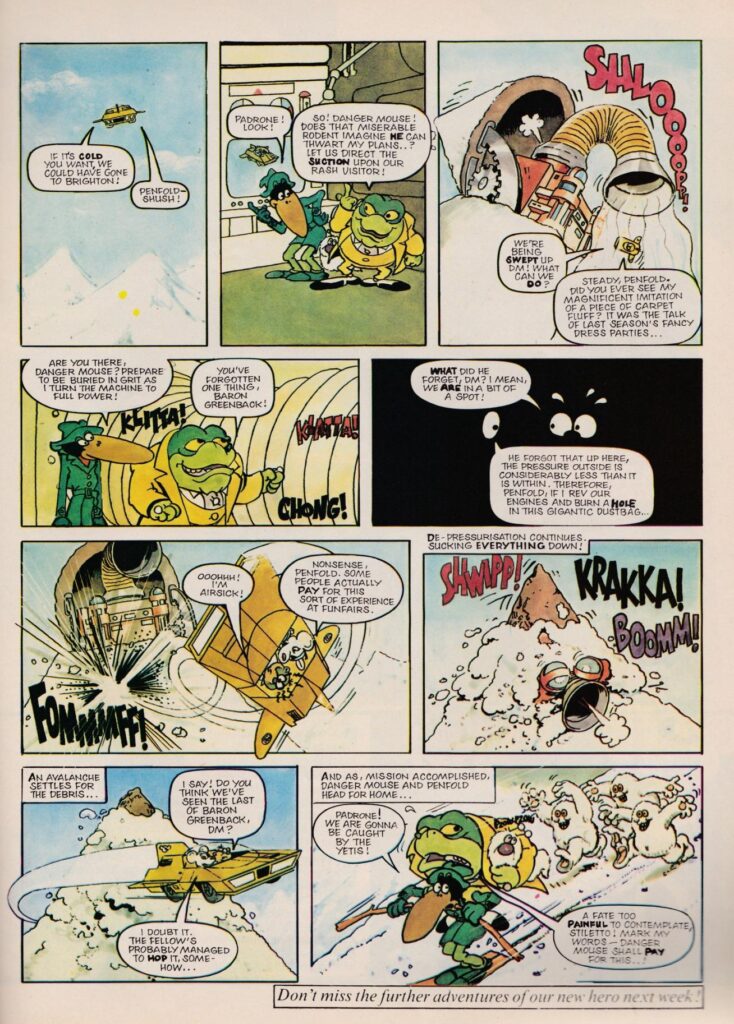
I’ll prompt you for a few more, shall I? How about … “Magnum P. I.”, “Haircut 100”, “Madness”, “Star Fleet”, “Into the Labyrinth”, “Murphy’s Mob”, “Bucks Fizz”, “Knight Rider”, “Terrahawks”, “Robin of Sherwood”, “The A- Team”, “Super Gran”, “That”s My Boy” (what was in Colin Shelbourn’s tea that particular week?), “The A-Ha Story”, “Alias the Jester”, “(The) 5 Star (Life)”, “Inspector Gadget”…?
Yes, I wrote all of those too. If they’re in Look-In, twenty to one, they’re mine.
It’s probably easier to ask which strips you didn’t write …
No, I never wrote the Leslie Crowther strip (“Crowther in Trouble”), never “The Benny Hill Page”. They were written by an awful nice guy named Geoff Cowan, who married Alan Fennell’s most beautiful secretary, and was, for a time, Chief Sub-Editor of Look-In.
Geoff used to infuriate me, because he was passionate about using quotes. I think he must have been paid by the quote. He put everything in the damned things, and I once told Alan that if he (Alan) didn’t stop Geoff putting quotes round words in my scripts I would kill him (Geoff). Happily, it never came to that. Geoff wrote the “Cannon & Ball” strip in the 1980s, too.
“On The Buses” was written by my old pal Scott Goodall, who coincidentally lives about fifteen miles away from me here in France.
You can always tell Geoff’s strips from mine, because he spelled a long-drawn out cry for assistance as “Heeeeeelp!” whereas I, thinking that nobody shouted the word with a prolonged ‘e’, preferred “Helllllp!”.
Once upon a time, to digress a little on a different but related subject, Scott Goodall, Tom Tully and I were in the Hoop and Grapes, opposite Fleetway in Farringdon Street, arguing about the ‘art effect’ THAKKA-THAKKA-THAKKA. Tom reckoned it was the sound of a light machine gun. Scott and I believed it to be the sound of a helicopter. The argument became quite heated, and I was amused to notice that the rest of the pub’s clientele had fallen silent and was collectively standing there, open-mouthed, as though listening to escaped lunatics!
“The Smurfs” was of course a syndicated strip. I had to write a column, each week, apparently from Pierre the Clown, as I recall, that tied in with the thing. It was all done in conjunction with some petrol company or other [it was the National garages; I well remember forcing my parents to go to their garages so we could get Smurf window stickers! – Alistair]. Pierre The Clown – Peter Picton, the descendant of the famous General Picton – was an enthusiastic barfly, comme moi. We hit it off very well. But eventually the Smurfs came to their end, and so did we.
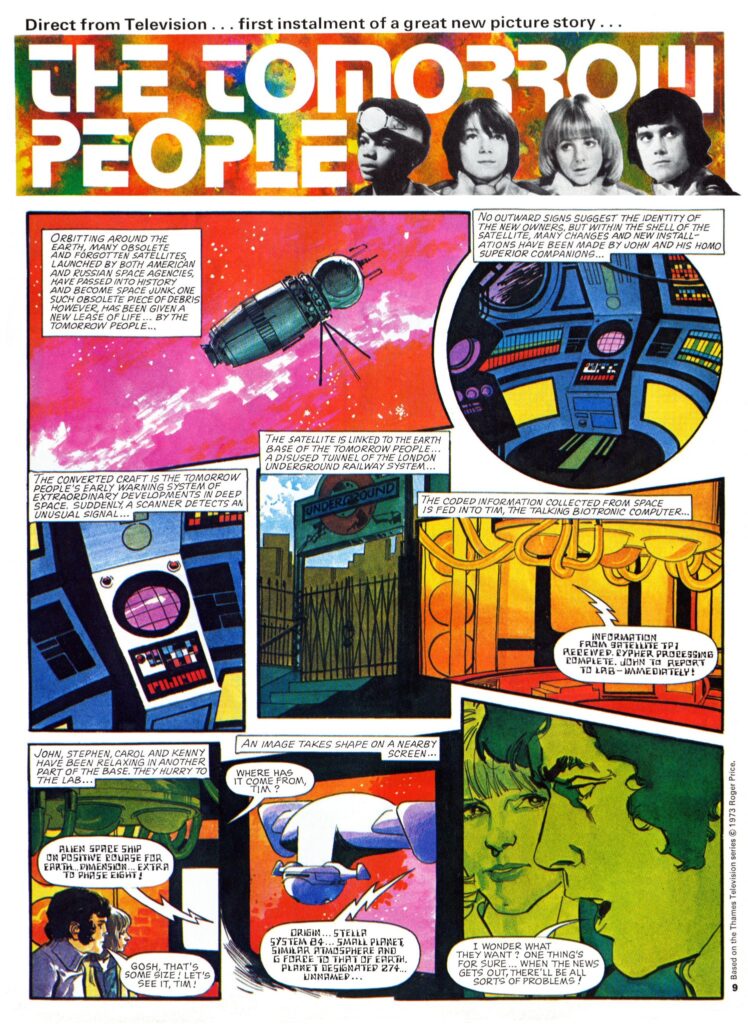
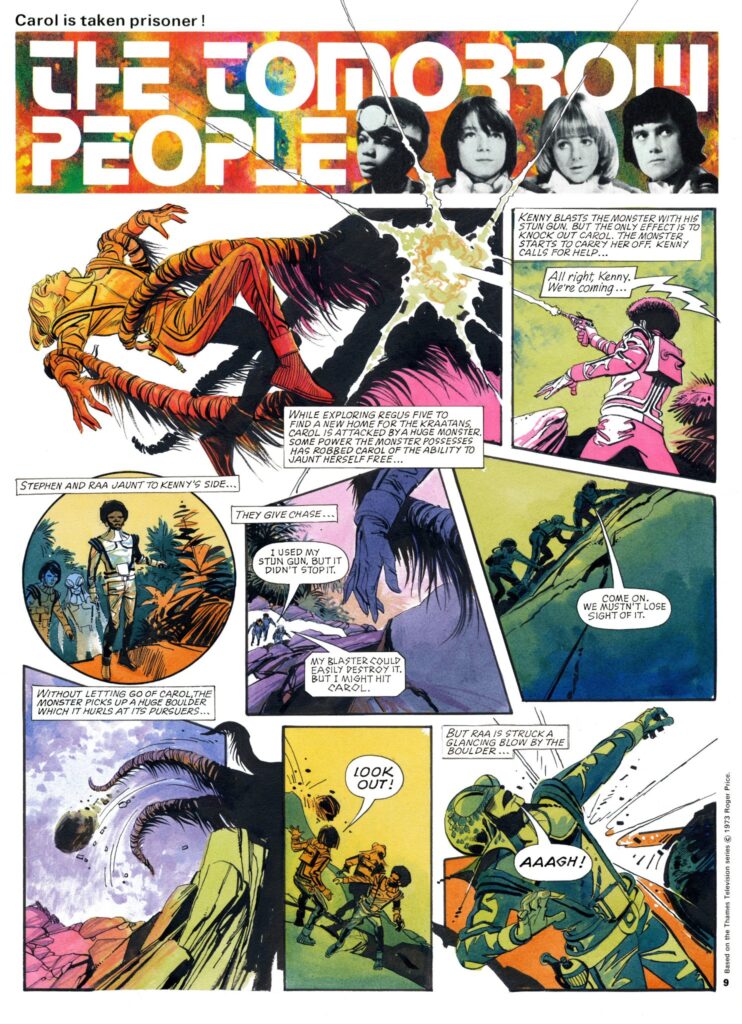
It’s widely assumed that Roger Price wrote the “The Tomorrow People” strip for Look-In so would you like to take your bow now in front of these nice people?
Yes, I wrote “The Tomorrow People” myself – I’m happy to say that Roger Price was very complimentary indeed about my work. I used to go down to watch the rehearsal for the series in Hampton, and often Alan Fennell and I would have lunch with Roger out at the studios.
There was a time when Roger proposed that I join him writing in some project or other, but it never came about, and I can’t even remember what it was! So, no, Roger never wrote anything for the comic. Neither did [Sapphire & Steel creator] P. J. Hammond. For one thing, Alan Fennell would never have paid them enough! Generous personally, he was unbelievably stingy with company money – this made him a much-respected editor thanks to his always coming in under budget!
I used to ask him, peevishly, why he never told whether he liked my stuff. “‘Cos you’d bleedin’ well ask for a rise,” he’d reply.
Did you have much other contact with TV cast and crews then?
No, I seldom had contact with TV people. They always tended to sneer at Look-In anyway, and there were a few occasions where I had to bang the table at PR types from various TV companies when they curled their lips and remarked, “Oh, you represent such a tiny little magazine”. It got up my nose. Especially when our sales touched the half million mark, thanks to series like “Kung Fu”, the awful David Cassidy, and later, “Danger Mouse”.
Sadly, British actors and the like were just the same. On the other hand, American actors, like Space: 1999’s Martin Landau, were charming and interested. Of course, they have a different attitude in the States to comic strips [and as Angus’s 1975 Space:1999 annual notes, Landau used to
work as a newspaper cartoonist so he would have been particularly interested – Alistair]. As they do here in France. It’s only in the UK that ‘intellectuals’ run them down. The saps. I don’t mean Saps. I mean several other four-letter words.
I had a very nice feedback from Keith Waterhouse himself on the first “Worzel Gummidge”, which Arthur Ranson drew. I remember having Worzel wanting a ‘babby’ and kidnapping a ventriloquist’s dummy, with which he became vastly annoyed because it wouldn’t speak. Keith said that he wished he’d thought of the idea himself, which I took as a real compliment. He was one of my favourite authors/journalists at the time.
When I did go down to see casts, directors and so forth in action at various studios, I was never totally happy about it for other reasons. Rehearsals – and even shooting – are so damned boring if one has only to stand around and watch. I was on set for various The Tomorrow People rehearsals, for example, and yawned all the time.
What can I say – I’m aghast!
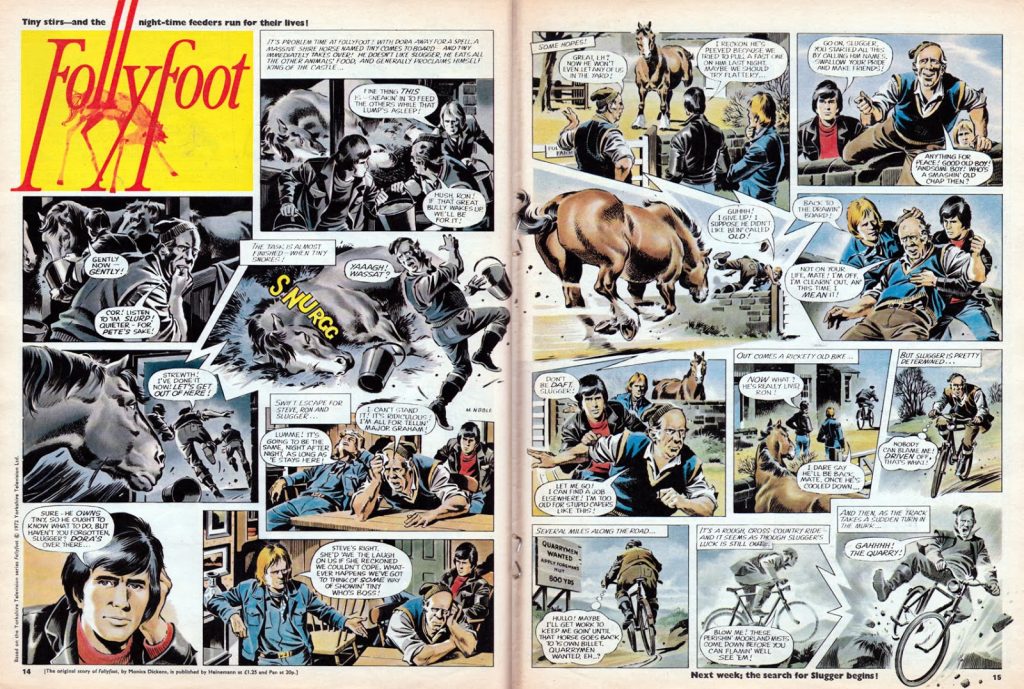
I did accompany the Follyfoot team to Aviemore for the purpose of writing a Follyfoot Special for Look-In[this was issued to tie-in with the launch of the show’s third series – Alistair]. That was great fun. We were also at YTV studios, Leeds with them, accompanying the shooting somewhere on location. Arthur English was an exceptional joy, and Chris Rodska and Steve Hodson were good company.
I also accompanied the groups, Slik and Flintlock, to several venues, in order to get interviews from them all. That was fine, because we all got on very well. Flintlock, especially, came to regard me as a sort of boozy avuncular mascot. Young Holloway, however, I never really knew. They kept him under wraps as though he was Elvis.
Any strips you really loved doing and any that were a total chore? I’m sure you would have enjoyed writing your own “Famous Five” stories, for example, but I gather the Enid Blyton Foundation nixed that and made you adapt the Blyton books?
Yes, the Enid Blyton strips were murder. As with the Just William series, I had to use original stories because of copyright ownership pressure, and as you know, the stories were never originally envisaged as being picture strips. They were most difficult to put into pictures, because they had convoluted plots. One can dredge up something from a text story from twenty pages back, without a problem, but you can’t do the same thing with a strip. Not unless it is published in a sixty-four page book.
I would say that these two particular strips were my least favourite. They were chores. I had to use someone else’s stories, and I didn’t like that. It’s not a prima-donna thing. I never cared, for example, for Blyton’s stuff when I was a kid. Therefore, it was a drag for me to script.
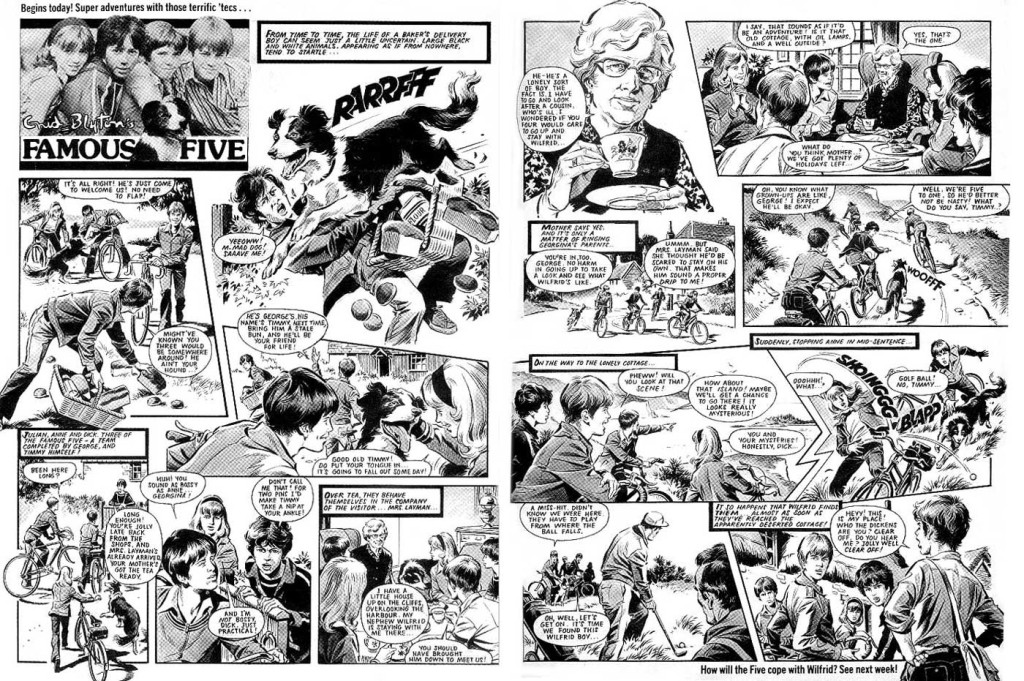
Richmal Crompton was different. I loved the Just William stories. However, they were also difficult to adapt. So much relied on words rather than on pictures in the original. Redgauntlet was a pain too [a serialisation of a Scottish Television serialisation of a Sir Walter Scott novel, first shown in 1970 – Alistair]. Putting complex plots like those of Walter Scott into a running picture serial was like being in hell.
Now – if only someone had asked me to script write the Hornblower stories of Cecil Scott Forester. For me, he was the perfect writer. His stories flowed, as every good story should. A to B, and no farting about with digressions to G and H and M.
My most favourite scripts were – for Lady Penelope, “The Monkees”, as drawn by Harry Lindfield. And “Danger Mouse”, as drawn by the incomparable Arthur Ranson, a bar-bellying buddy of mine whom I miss greatly.
Do you know, Arthur is the most self-effacing artist I have ever known. I always thought he was brilliant, yet he had scant confidence in himself. He would slave for hours at a Grant Projector to get his pictures [a device that allows artists to trace photographs – Alistair], rather than draw them freehand. Arthur is someone I respect and admire greatly. He and I, I reckon, did a great deal for Look-In over the years. We discussed our plans and worked out our ploys in a nice, old fashioned Victorian pub near to where Arthur lived, in Wandsworth, The County Arms. It should have a plaque.
Going back to “The Monkees”, I saw the pilot episode with Alan Fennell and his minions at some preview theatre in Soho. It was brilliant. I remember saying: “These characters will flatten The Beatles”. Typically, the pilot was never shown, and the actual series was a load of crap. The stuff I wrote, initially drawn by Tom Kerr, and later by Harry, was, I think, infinitely better than anything on screen. It possibly went over the readers’ heads, but I enjoyed writing it more than anything I have ever done.
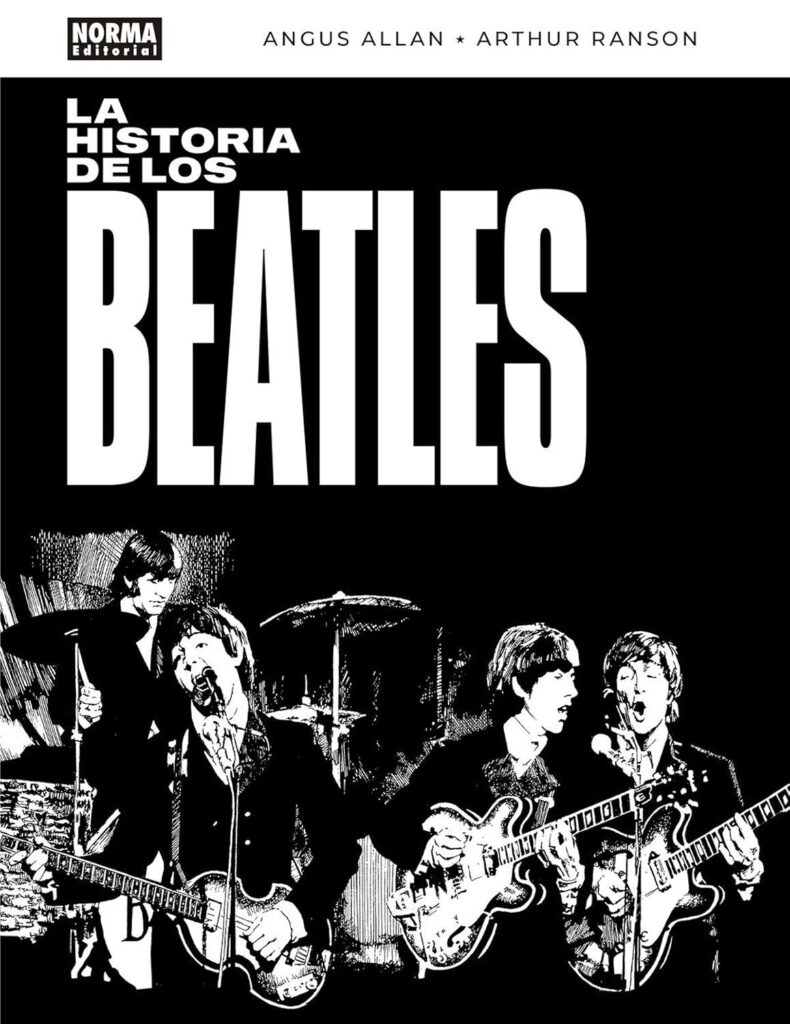
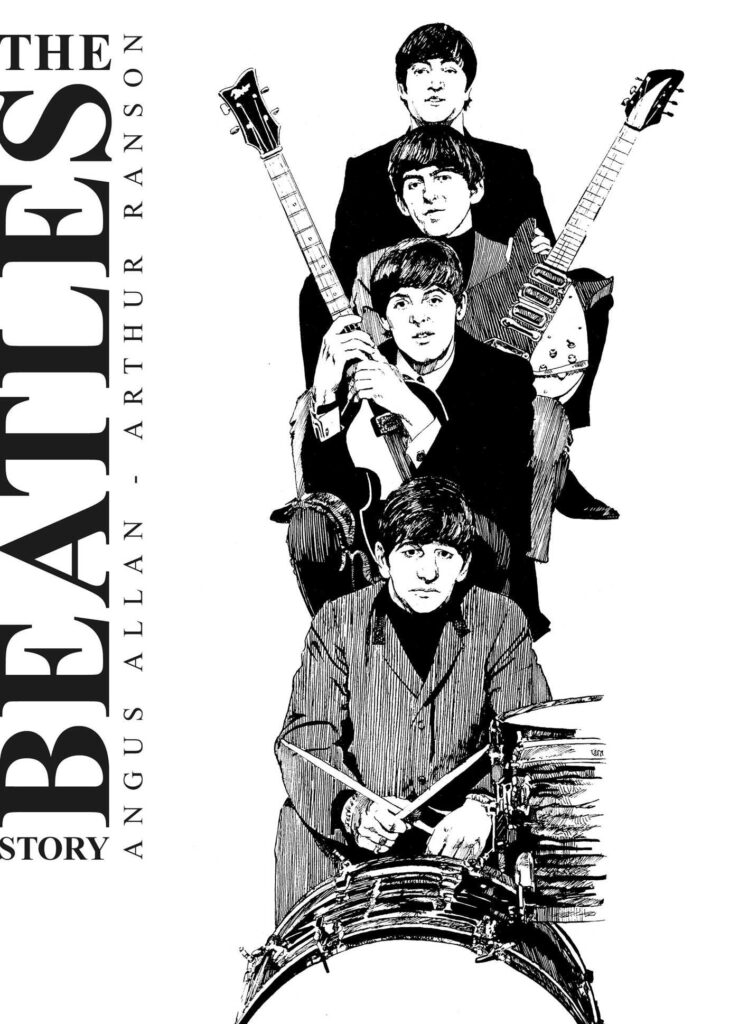
Did any strips fall through due to rights (i.e. money!) issues or second thoughts on the editorial staff’s part that you can remember thinking might have been fun to do? Ace of Wands, Thames TV’s fantasy adventure series of the early 1970s is said to have almost been turned into strip form. And I’d love to have seen a New Avengers” strip – was that considered at any time? Star Maidens, Return of the Saint, The Muppets are other series that spring to mind. Any really wacky pop groups ideas that fell through? The Wild Adventures of Kim Wilde?
Well, I can’t actually admit to having been bothered about “might have beens”. Such is the (possibly sneerworthy) attitude of the money-grubbing professional. I did manage The Avengers, but only on the basis of some annuals for Seymour Press when Linda Thorson was the female lead.
We did have a chance to do The Muppets for Look-In – I went with Alan Fennell to a preview, and actually turned in a sample script. But for some reason or other, it all fell through. I imagine that the Muppets production company was asking too much from Alan for the rights. As I said, he was an astute man, and only nodded his head for the very best deals for his company.
During the tenure of Colin Shelbourn as editor [Alan Fennell left for World Distributors during 1975 after they made him “an offer he couldn’t refuse” – Alistair], we did toy with one or two jobs that never came about. There was a family group of singers from Birmingham – I forget the group’s name. ‘Pass The Duchy On The Left Hand Side’ was their initial hit [Musical Youth! – Alistair]. We were going to sign ‘em up forLook-In, and I wrote a script. They liked it, but they decided they would rather start a comic themselves, with – naturally – themselves as the front-page stars. You remember the launch? No, neither do I. It never happened.
The mind boggles!
There was also “Metal Mickey”, a laudable programme concerning a robot within a middle-class family, which actually included Irene Handl. We had terrible trouble with it. My first scripts were turned down, then I re-wrote, but the Metal Mickey entrepreneur didn’t like Bill Titcombe’s drawings, so we ditched the whole idea. Great pity … though in truth, the TV series didn’t exactly do wonders.
Your DC Thomson rival of the time, (TV) TOPS eventually carried a ‘Mickey’ strip, so it would seem a deal was struck somewhere. Maybe they offered a few more cups of oil than your lot.
I wouldn’t say I was a normal child (!) but I always wanted to know who wrote and drew the comics I read. Did you not find it annoying that you were never credited (except for some reprints in the later annuals!)? Artists could at least sign their artwork, so you knew who was responsible. You got a photo at the Space City Gerry Anderson exhibition in Blackpool as part of the Space: 1999 comics display, but that’s about all!
Credits were never terribly important to me. I – seventh son of a seventh son that I am – could foresee the future. I knew that one day there would be this thing called the Internet. Nah, but seriously, it wasn’t such a big deal. I always knew that the artist was far more important than the writer. Sure, few artists could actually do a script from scratch, but it is, after all, the impact of their drawing that catches the eye and snares interest. So they have the right to sign their stuff.
It happened that, on occasion, damp-eyed and sympathetic chaps like Martin Asbury, who had listened tearfully to my bleating, added my name to the strip as writer. I think, on Look-In, a couple got through before Alan Fennell cried out with furious rage and had ‘Angus Allan’ wiped from the originals. I responded by treading on his blue suede shoes.
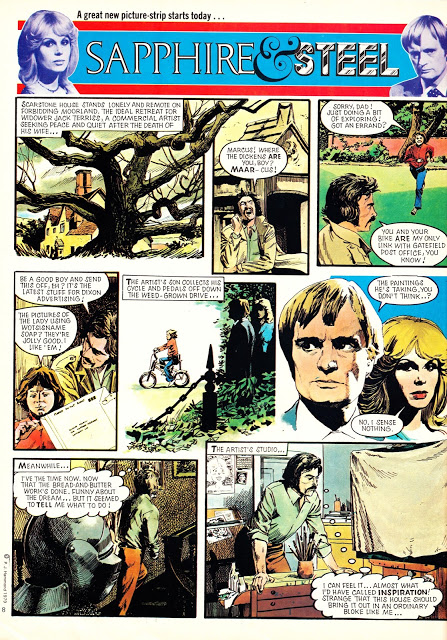
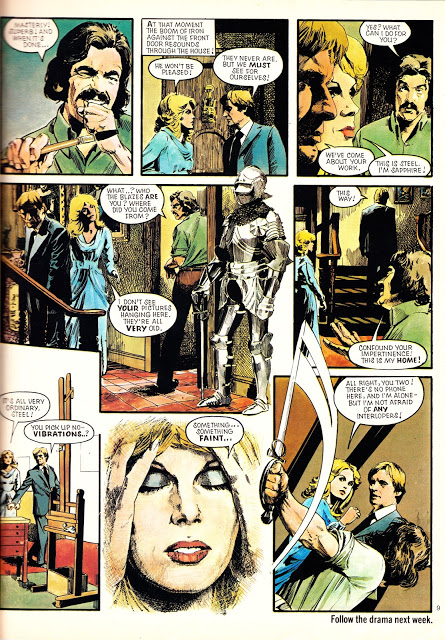
Having a look at my back issues, you are absolutely right. You got a credit scribbled in on a couple of “The Six Million Dollar Man” episodes in 1976 …
Do you remember would-be rivals to Look-In, (TV) TOPS and BEEB? Did they ever try to poach you (I think some of the Look-In artists worked for these titles)?
I do not remember the rivals to Look-In that you mention. No kidding – and I’m not being daft or prima-donna-ish or silly – I have no knowledge of any rivals. As far as I was concerned, there were none. Such is confidence in oneself and the publication one works for. I reckoned it was the best, and had no challenge.
TOPS ran some quite ‘cool’ strips like “Minder” and “The Professionals” – I think it was quite popular initially, but it only lasted two years.
I did do both Minder and Professionals annuals for another company – the name escapes me, but it was a small company run by the Babani brothers in London [Grandreams – Alistair]. I also did ‘Allo ‘Allo for them.
The Minder one was especially bizarre, as George Cole refused to have anything to do with it. I think that possibly the Babanis weren’t offering him enough. So a Minder Annual came out with plenty about Dennis Waterman in both strip and feature and text story, but with an Arthur Daley who had a spiv moustache, and was merely called ‘guvnor’ or something like that! Totally ridiculous.
My own personal interest in Look-In, as a regular reader, ended around 1984 when I graduated to Smash Hits, but I know you continued to work at Look-In on strips such as “Robin of Sherwood” and “The A- Team”. You ran into problems with violence in these strips – is that what ended your relationship with the comic?
My relationship with the comic ended slowly. It began with the increasing editorial pressure to diminish and finally ban all violence, at whatever level. I cannot now imagine why Look-In continued to pay for the rights to The A-Team while forbidding me even to show a pistol in the strip. Insane.
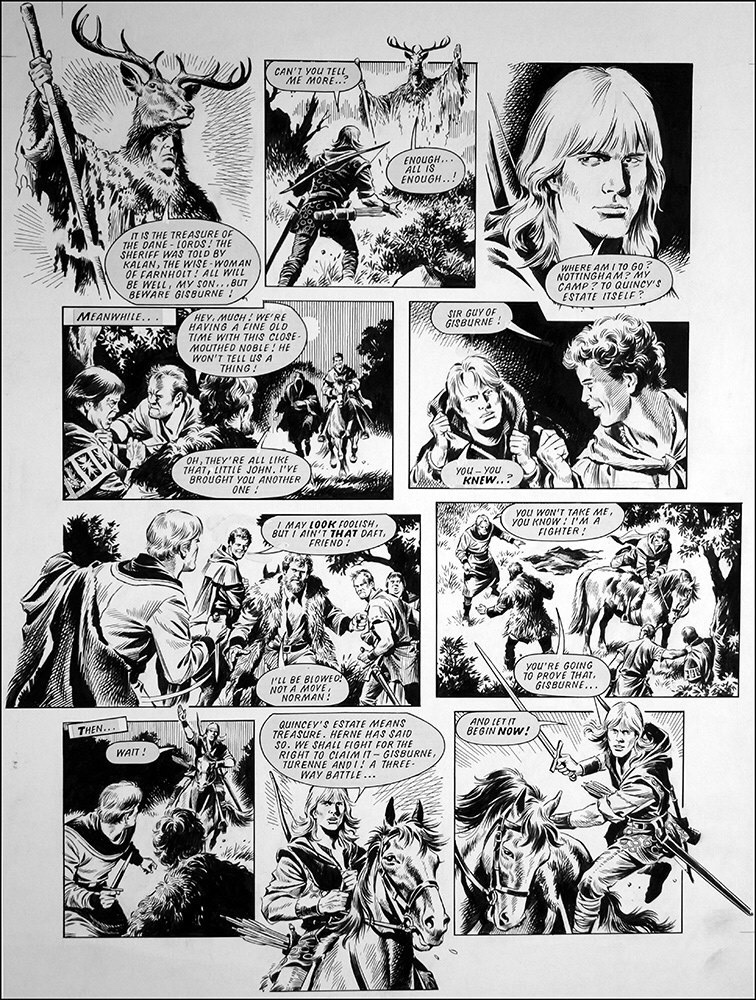
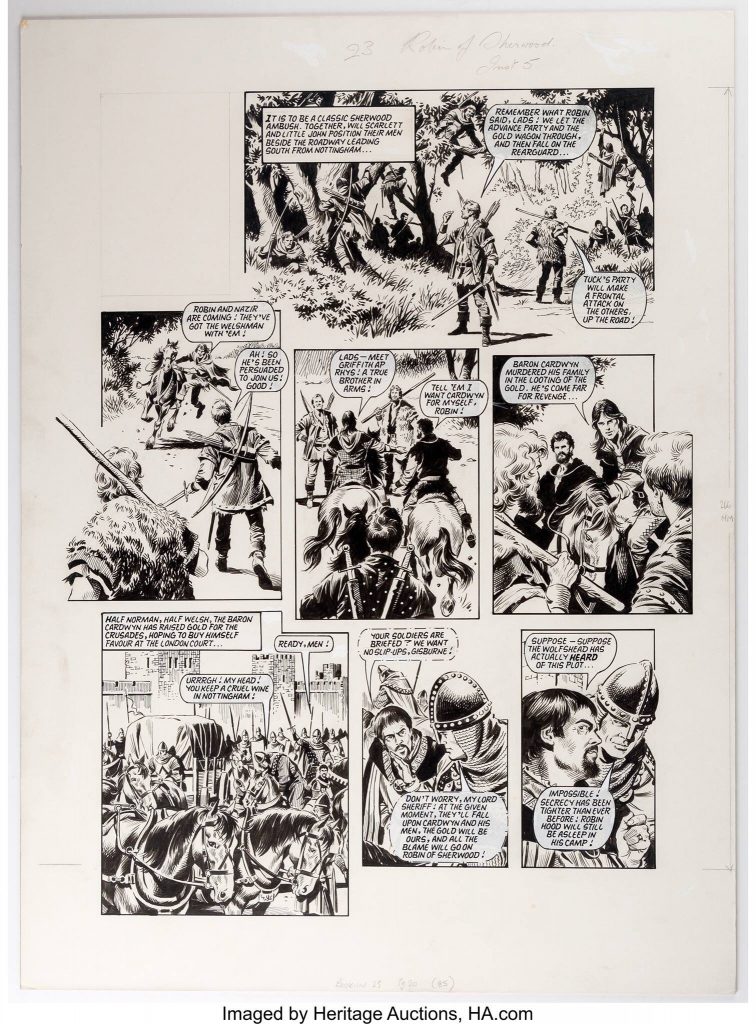
And when the editor [Colin Shelbourn] bought Robin of Sherwood and asked me to write it without bows and arrows … well! The ensuing argument resulted in getting my own way, but I had to promise to use arrows only to send messages or convey climbing lines to castle battlements. What a nonsense! It was at that time that Look-In began to fall heavily in circulation, and no wonder. I don’t agree with blood and gore and mindless violence at all, but kids love a bit of mayhem, and God knows there’s enough of the real thing around.
I’ve seen some issues from the late 1980s/early 90s and they really are awful, just gaudy poster magazines with the odd three-panel ‘funnies’ strip, very poorly drawn and hardly written at all so it’s clear Angus Allan was no longer around …
From the mid-1980s on, it was down the pan. Scooby Doo? Gad, I had to write it – and what a bore! Inspector Gadget? I had to write that, too [this was around 1987 – Alistair]. I was near to suicide until I went over to France for a weekend and discovered that a family I met in a bar thought I was Jesus, because I wrote Inspector Gadget for an English publication.
Duckula had taken over as the main strip in Look-In [circa 1988 – Alistair]. And someone else was writing it. I was annoyed. I should have been. When “Danger Mouse” had been running for a while, the big man up there at Cosgrove Hall, Brian Cosgrove, was so impressed with the scripts we ran that he asked to use them as on-screen cartoons. I actually got credited [although occasionally erroneously on-screen as ‘Angus Allen’ – Alistair). And after that, he asked me to write a couple of originals for the series. It isn’t often that a comic strip spin-off engenders that sort of thing.
Blowing my own trumpet? You bet. I’m proud of it!
You relocated to the South of France many years ago now and you run a farm there with your wife Gillian?
Yes – here I am with my wife Gillian (ex- editress of Penelope, and latterly Chief Sub Editor of Woman’s Own before it became a load of merde). In the South West of France we are retired among eight acres of wild meadow and woodland, which we are successfully converting to a dreamlike garden. We have our own natural spring of clear, pure water, which goes superbly with any booze you care to mention. I write no more – merely because [comic] markets are all gone – but play clarinet with a local Dixieland jazz band.
Did you keep any mementoes of your times at TV21 and Look-In? I probably don’t want to know the answer to this – but what happened to all of the thousands of pages of original art from Look-In?
Artwork was retained by the publishers, usually. And when I think what happened to it all! Except for bits and pieces salvaged here and there by the artists (some of which I possess) it all eventually went to the furnace. My God, if only I’d plundered it by the cartload, I’d be able to grow rich! To think that I once had my hands on 64 pages of Ron Embleton originals for Kit Carson – his first strip away from the pulp/junk comics, and written by me. Oh well, at least I have a set of glossy art pulls of the thing, but that’s not quite the same.
I believe Alan Fennell, who was most astute, saved a lot of TV Century 21 original stuff, but when he died, nobody could find it. I dare say it got slung out somewhere.
I have not brought all my copies of TV21 and Look-In with me, because there wasn’t a removal van large enough. I retain all the annuals I ever wrote, and some specials. Some TV21 Captain Scarlet records I wrote.
Also – a prized possession, which looks sternly at me now – my “Good Grief Oh Crikey Services To Danger Mouse” Award. I don’t think there are many of those about …
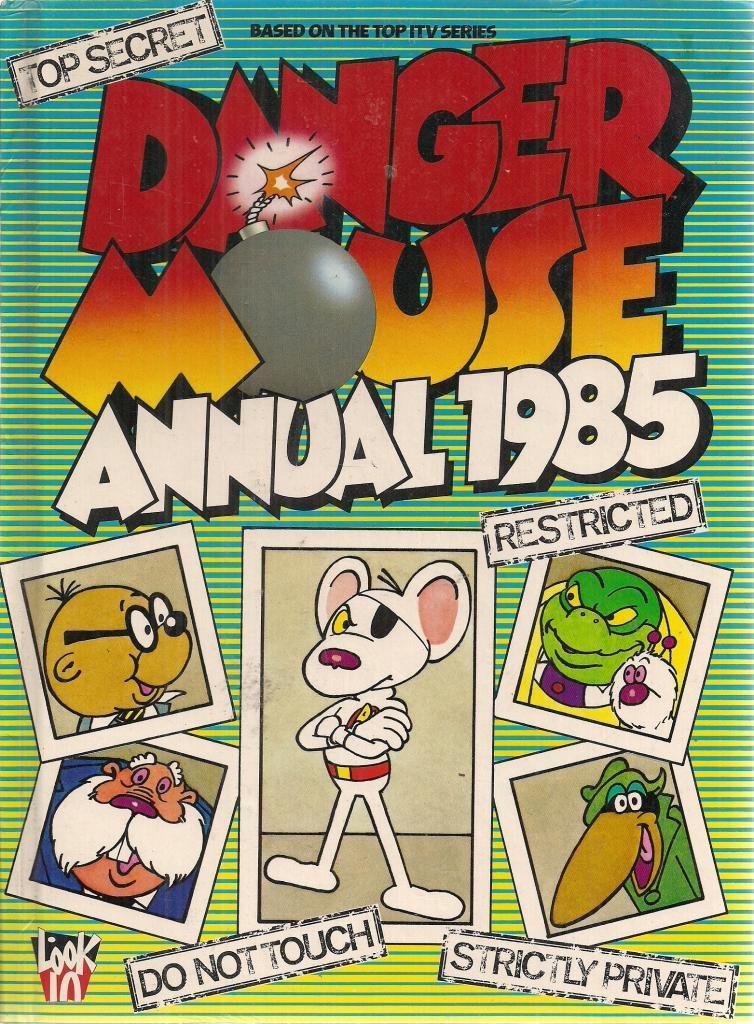
From Look-In, I’ve got a piece of Martin Asbury original artwork from “The Six Million Dollar Man” hanging up right here in front of me, alongside various other bits and pieces. I managed to get Martin to give me some pages, and John M. Burns kindly let me keep a couple of “Smuggler” black and whites and a couple of “Magnum” full colour pages, which adorn our staircase here along with various other strip originals. I like it better than The Louvre – and … “Yah-hah-harrrrr! IT’S ALL MIIIIIINE!”
Angus Allan – thank you so much!
Angus Peter Allan passed on 16th July 2007
Our thanks to Alistair McGown for permission to republish this archive interview
Further Reading…
• Read Alistair McGown’s Archive Interview with artist Martin Ashbury
Dan Dare: Pilot of the Future
by Angus P. Allan
Paperback, Published in 1977 by New English Library
ISBN: 978-0450033209
• Buy it from AmazonUK (Affiliate Link)
A novelisation of the early “Dan Dare” stories from EAGLE, utilising black and white illustrations taken from the strip throughout. One of a series of books that included adaptations of comic strips: “No Tears for Molly” by June Vincent, “Roy of the Rovers” by James Hart, and “D-Day Dawson” by Marcus Allgood
Thrilling Stories of Mystery and Adventure (Falcon Fiction Club)
by John Radford, M. S. Goodall, Angus Allan, John Wagner, Terry Deary, Kelvin Gosnell, Allen Sadler, Brian Burrell, Kay Wilson, Ivan Lapper, Hamlyn Publishing
Published 1982 by Hamlyn
ISBN-13: 978-0600366799
• Buy it from AmazonUK (Affiliate Link)
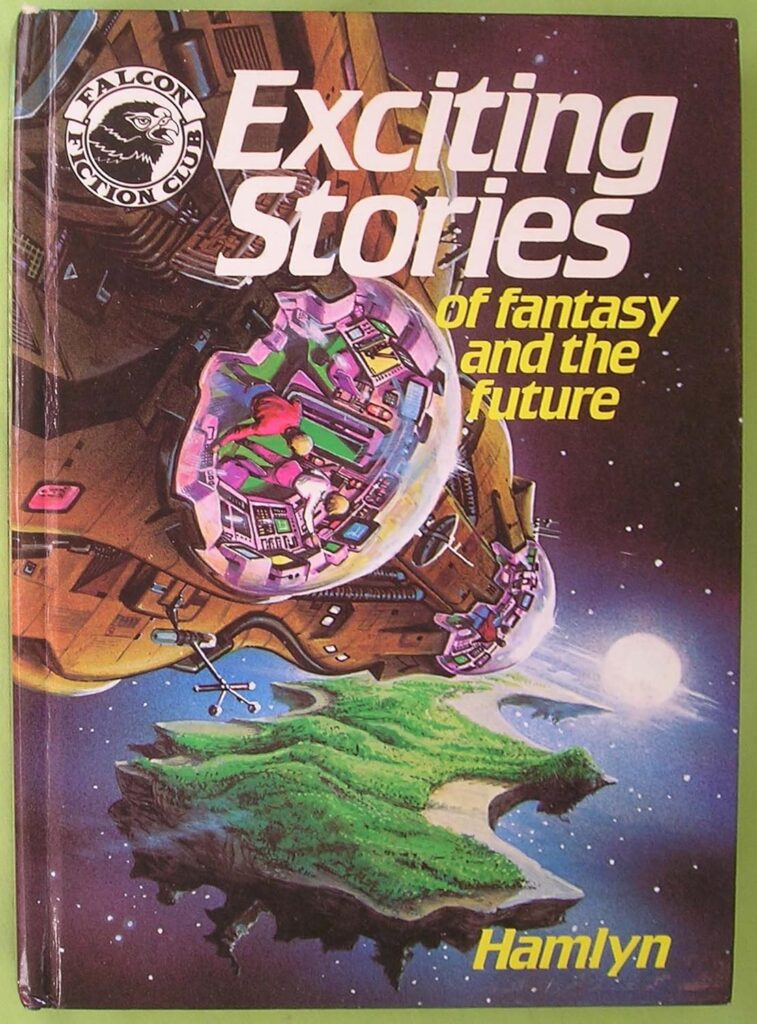
Exciting Stories of Fantasy and the Future (Falcon Fiction Club)
by Oliver Frey, Alan A. Grant, John Wagner, Kelvin Gosnell, Angus Allan, John Radford, Adrian Vincent, Lee Stone, M. S. Goodall, Ralph L. Sells, Andrew Muir, S. H. Lewis
Published 1984 by Hamlyn
ISBN-13: 978-0600366775
• Buy it from AmazonUK (Affiliate Link)
The Beatles Story
by Arthur Ranson, Angus Allan
Hardcover, 56 Pages, Published 2018 by Rebellion
ISBN-13: 978-1781086179
• Buy it from AmazonUK (Affiliate Link)
A collection of “The Beatles Story” from Look-In, the strip rights owned by Angus Allan and Arthur Ranson, along with “The Elvis Story”
Alistair McGown is part of the design team on Panini’s range of Doctor Who bookazines and special editions, and also designs the Fanderson newsletter, FAB Express.
The Fanzine Book – his look back at the history of the golden age of Doctor Who underground fanzines in the 1970s and 80s – was published by Telos in 2023 and is due out in paperback later this year.
The titles Look-In and TV Century 21 and TV21 © Rebellion Publishing. Comics strips featured © respective companies and creators
Categories: British Comics, Comic Creator Interviews, Comics, Creating Comics, Features, Licensing, Other Worlds, Television
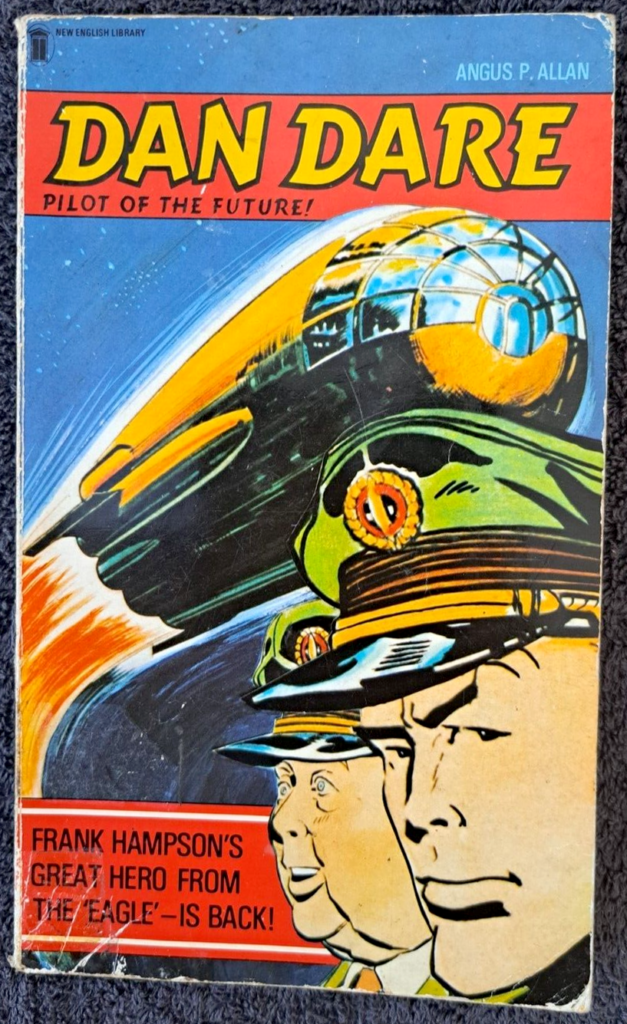
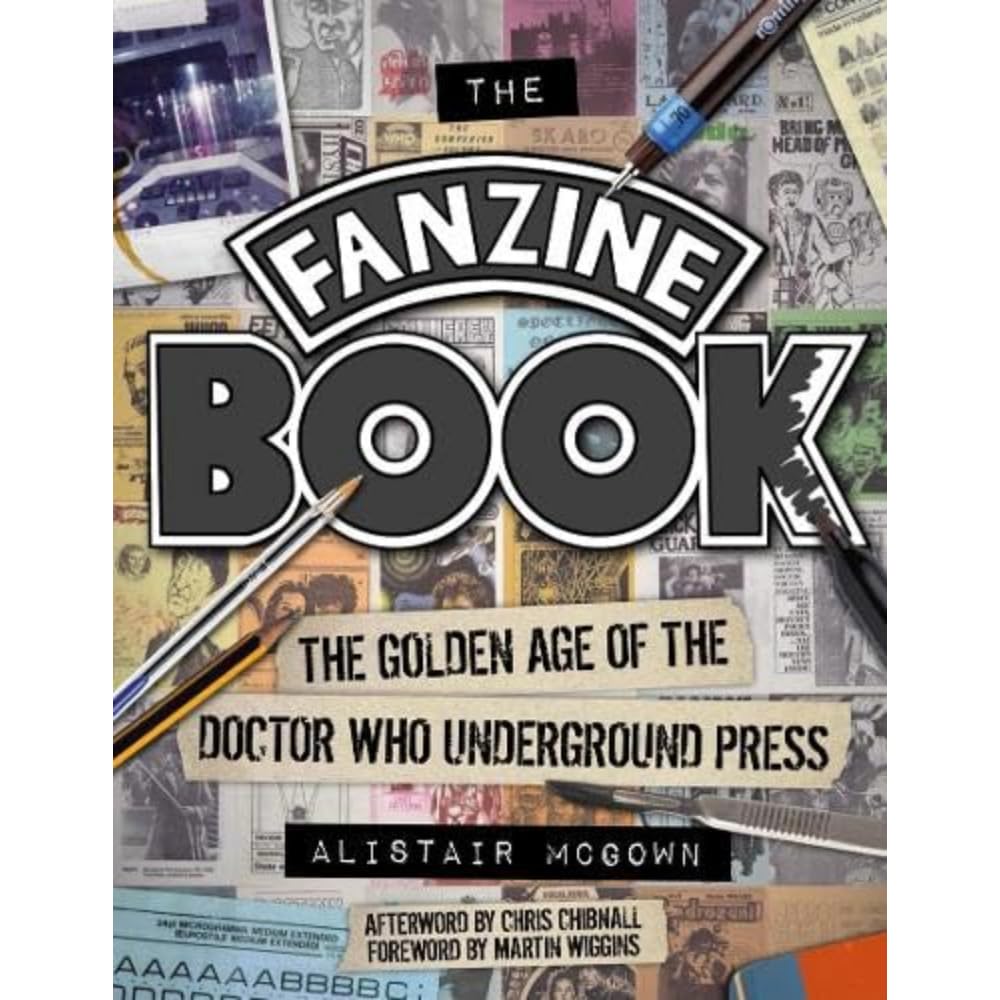
 Creating Comics: Cutaway Comics explores the greater Doctor Who universe
Creating Comics: Cutaway Comics explores the greater Doctor Who universe